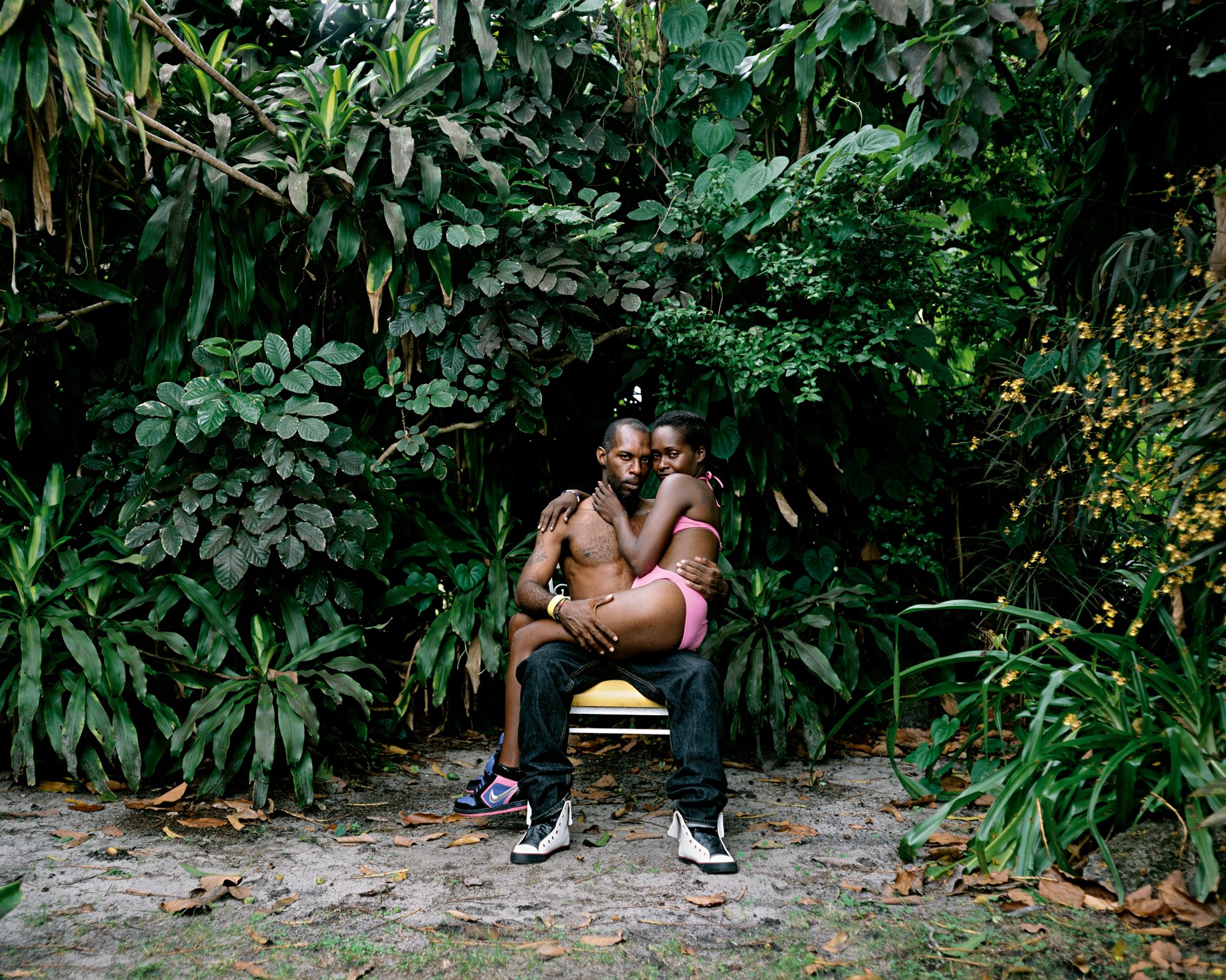Deana Lawson’s mythical portraits of blackness
- Text by Miss Rosen
- Photography by Deana Lawson / courtesy Rhona Hoffman Gallery and Sikkema Jenkins, Co.

Deana Lawson’s photographs embody the realm of myth, a space where the divine and mortal realms merge.
They centre around the subjects of family, spirituality, sexuality, and intimacy within the black experience, in the US, the Caribbean, and Africa. She credits Carrie Mae Weems and Renee Cox for piquing her interest in documenting issues of race and identity, as well as cultivating a nuanced conversation around black aesthetic in both art and daily life.
Now living in Brooklyn, Lawson draws inspiration from everything – from vintage nudes, juke joints and acrylic nails, to fried fish, lace curtains, the Notorious B.I.G. and thrift shops. Her large-scale photographs are extremely formalist and meticulously staged, but they’re also profoundly intimate studies of black life around the globe today.

Deana Lawson, Oath , 2013; from Deana Lawson: An Aperture Monograph
Her first monograph, Deana Lawson (Aperture), presents 40 key works made over the past decade in the US, the Caribbean, and Africa. A selection of 13 photographs and a new film will be on view in Deana Lawson, the new exhibition opening at the Underground Museum in Los Angeles on October 12, 2018.
Hailing from Rochester, New York (the home of Eastman Kodak), mythology has informed Lawson’s life. Her family had several connections to George Eastman and the company, while her father was a photographer.
“Deana claims she was predestined to become a photographer,” explains Megan Steinman, Director of the Underground Museum.
“Her images are so layered and complex conceptually that you can get turned around by them, but in the most beautiful way, because it has the mythology of black lives that takes you across dimensions and across time. She stretches back to Africa, and the Transatlantic Slave trade to the Industrial Revolution, Jim Crow, and the Harlem Renaissance, to the keepers of incredible archives of art and creativity: the mothers, sisters, fathers, brothers, and cousins, the kids on a playground, and the mundanity of everyday life.”

Deana Lawson, Nation , 2018; from Deana Lawson: An Aperture Monograph
Lawson’s subjects are usually strangers she meets in public places. She then steps inside their world to explore how they express their identities within the privacy of their own homes. Her photographs show us how her subjects see themselves, and she allows us to look at the ways in which personal style, facial expression, posture, and interior décor interact in a new kind of portraiture that could be described as domestic formalism.
“I’ve rarely seen more powerful subjects in a photograph than in Deana’s photographs,” Steinman says. “They are strangers and in the process of meeting them, inviting them to be part of their work, and composing them within the frame of her photograph, she has managed to never take from their own personal agency. In that gift of agency, of the subjects looking back at you, you understand how you yourself have agency, and you feel that transfer of power that’s happening between photographer, subject, and viewer. In Deana’s work, the power is a three-way shared responsibility so that everyone is taking care of the other person.”
Lawson’s work eradicates the insidious presence of the white gaze, creating a conversation that exists free from the bind of double consciousness. “Deana talks about demonstrating a beauty that has always been there,” Steinman adds.
“The majority of our audience, which is black and brown, come in and really sit with that. I hope that message is transferred, not just theoretically, but that all audience leaves with a very full heart and a very loving knowledge of that kind of beautiful blackness.”

Deana Lawson, Coulson Family, 2008; from Deana Lawson: An Aperture Monograph

Deana Lawson, Nikki’s Kitchen , 2015; from Deana Lawson: An Aperture Monograph

Deana Lawson, Mama Goma , 2014; from Deana Lawson: An Aperture Monograph
Deana Lawson will be on view at the Underground Museum in Los Angeles through February 17, 2019.
Follow Miss Rosen on Twitter.
Enjoyed this article? Like Huck on Facebook or follow us on Twitter.
You might like

In The Road to Patagonia, Matty Hannon holds “a mirror to the human condition”
From tip to tip — More than a surf and travel documentary, the Australian filmmaker meditates on capitalism’s pitfalls and the importance of existing within nature while embarking on a marathon journey from Alaska to Tierra del Fuego.
Written by: Sam Haddad

Largest-Ever Display of UK AIDS Memorial Quilt Opens at Tate Modern
Grief Made Visible — Comprising hundreds of panels made by lovers, friends and chosen family, the UK AIDS Memorial Quilt returns in full for the first time since 1994 – a testament to grief, friendship and the ongoing fight against HIV stigma.
Written by: Ella Glossop

In Medellín’s alleys and side streets, football’s founding spirit shines
Street Spirit — Granted two weeks of unfettered access, photographer Tom Ringsby captures the warmth and DIY essence of the Colombian city’s grassroots street football scene.
Written by: Isaac Muk

On Alexander Skarsgård’s trousers, The Rehearsal, and the importance of weirdos
Freaks and Finances — In the May edition of our monthly culture newsletter, columnist Emma Garland reflects on the Swedish actor’s Cannes look, Nathan Fielder’s wild ambition, and Jafaican.
Written by: Emma Garland

Dalia Al-Dujaili: “When you’re placeless, nature can fill the void”
Babylon, Albion — As her new book publishes, the British-Iraqi author speaks about connecting with the land as a second-generation migrant, plants as symbols of resistance, and being proud of her parents.
Written by: Zahra Onsori

We are all Mia Khalifa
How humour, therapy and community help Huck's latest cover star control her narrative.
Written by: Alya Mooro

